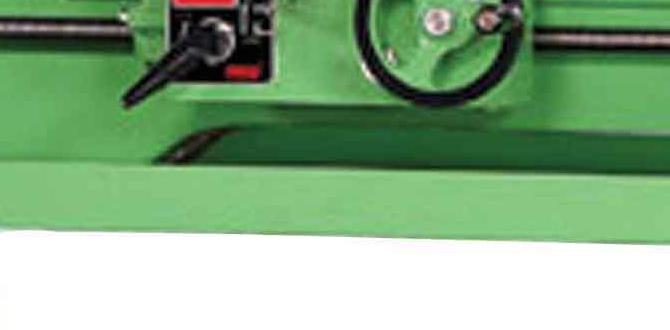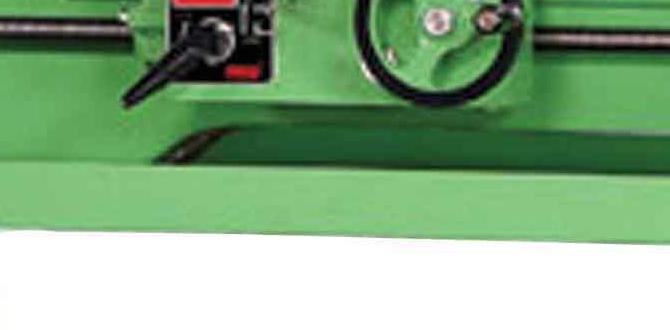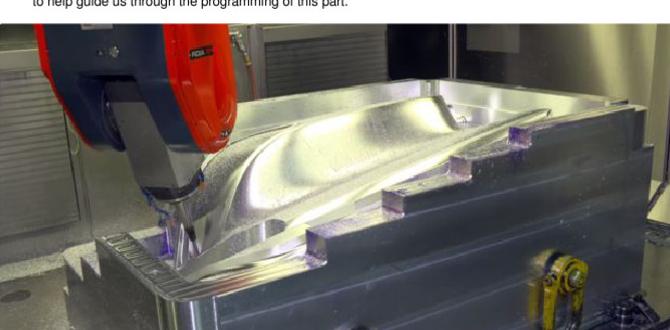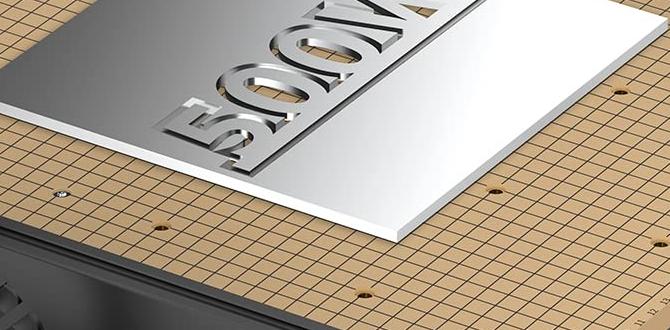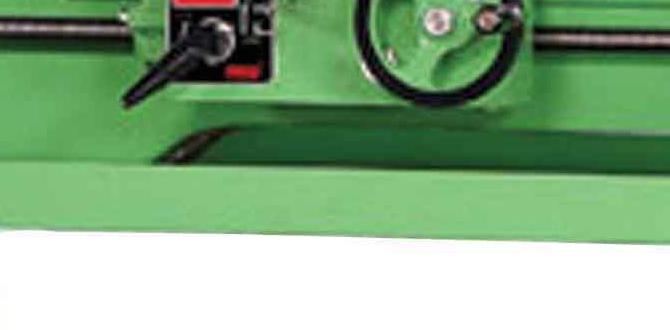Wood lathe vibration is often caused by an unbalanced workpiece, dull tools, incorrect tool rest placement, or an uneven machine base. Addressing these issues is key to smooth turning and achieving professional results.
Hey there, fellow woodturners! Daniel Bates here from Lathe Hub. Ever find yourself battling a vibrating wood lathe? That shaky, jarring motion can really throw a wrench in your project, making it tough to get clean cuts and smooth finishes. It’s a common frustration for beginners, and sometimes even experienced woodworkers run into it. But don’t worry, it’s usually something we can fix! In this guide, we’ll break down the most common culprits behind wood lathe vibration and show you exactly how to get your machine running smoothly again. Let’s turn that shake into a stable spin!
Understanding Wood Lathe Vibration: Why It Happens
That constant shimmy and shake from your wood lathe isn’t just annoying; it’s a sign that something’s not quite right. It can lead to rough surface finishes, tired tools, and even damage to your lathe or workpiece. Think of it like trying to paint a steady line on a wobbly table – it’s a recipe for disaster! The good news is that most wood lathe vibration issues stem from a few key areas that are relatively easy to diagnose and fix. By understanding these common causes, you’ll be well on your way to achieving that satisfying, smooth turning experience.
The Big Culprits: Essential Causes of Wood Lathe Vibration
Let’s dive into the most frequent reasons why your wood lathe might be shaking like a leaf in a hurricane. Pinpointing the exact cause is the first step to a smooth operation.
1. Unbalanced Workpiece
This is, by far, the most common culprit. When the wood you’re turning isn’t perfectly centered on the lathe’s headstock and tailstock, it creates an unbalanced mass that rocks back and forth as it spins. This is especially true when you start with irregularly shaped logs or large pieces that haven’t been “rounded” yet.
- Rough Stock: Green wood, knots, or irregular shapes naturally have uneven weight distribution.
- Mounting Issues: Not seating the wood properly on the spur drive and spur center can lead to imbalance from the get-go.
- Turning Shape: As you remove wood, the balance can change, especially if you’re creating asymmetrical shapes or turning away large sections on one side.
2. Dull or Damaged Turning Tools
Sharp tools are happy tools, and they’re essential for smooth turning. When your chisels and gouges are dull, they don’t cut the wood cleanly. Instead, they tear and push, creating uneven forces that can cause the lathe to vibrate.
- Dull Edges: A lack of sharpness means more force is needed to cut, leading to chatter and vibration.
- Incorrect Grind: A poorly ground bevel can also cause the tool to “dig in” or skip across the wood.
- Tool Construction: Sometimes, a poorly made tool or one with a looseferrule can introduce its own vibrations.
3. Incorrect Tool Rest Placement
The tool rest is your steadfast support while turning. If it’s too far away from the wood, your tool has excessive leverage and can chatter. If it’s too close, it can bind or catch, causing jolts.
- Distance: The ideal distance is usually no more than the diameter of a pencil (about 1/8 inch or 3mm) from the wood’s surface.
- Angle: The tool rest’s angle needs to be adjusted to match the bevel of your tool for efficient cutting without digging.
- Stability: Ensure the tool rest is securely locked in place; a wobbly rest translates directly into lathe vibration.
4. Loose or Worn Bearings
The bearings in both the headstock and tailstock are critical for smooth rotation. If they become loose, worn out, or lack proper lubrication, they can cause rough movement and contribute to vibration.
- Wear and Tear: Over time, especially with heavy use, bearings can degrade.
- Lack of Lubrication: Some lathes require periodic greasing of their bearings.
- Damage: Debris or improper handling can damage bearing surfaces.
5. Machine Stability and Leveling
Your wood lathe needs a solid, level foundation to operate at its best. If the lathe itself is wobbly, or if it’s sitting on an uneven floor, the vibrations will be amplified.
- Uneven Floor: Even a slight slope can cause imbalance.
- Loose Legs: Ensure all the lathe’s legs are firmly on the ground and not rocking.
- Bed Alignment: The lathe bed itself should be properly aligned and free from damage.
6. Incorrect Drive System Components
The drive system (e.g., headstock pulley, belt, motor) needs to be in good condition. Misaligned pulleys, a worn or damaged belt, or issues with the motor mount can all lead to vibrations.
- Belt Tension: A belt that’s too loose can slip, causing inconsistent speed and vibration. Too tight can strain bearings.
- Pulley Alignment: Pulleys that aren’t perfectly aligned can cause the belt to run unevenly.
- Motor Mount: A loose motor mount allows the motor to vibrate, and this vibration transfers to the lathe.
7. Tailstock Alignment Issues
Your tailstock needs to be perfectly aligned with the headstock for turning between centers. If it’s even slightly misaligned, the workpiece will be at an angle, leading to imbalance and vibration.
- Offset: The tailstock can become misaligned from impacts or if the locking mechanism isn’t fully engaged.
- Barrel Runout: The tailstock barrel itself might have a slight wobble if damaged.
Troubleshooting Steps: A Practical Guide to Fixing Vibration
Now that we know what can cause the shake, let’s get to work fixing it! Follow these steps systematically to identify and eliminate vibration.
Safety First! Always ensure the lathe is turned OFF and unplugged before making any adjustments or touching moving parts, especially when working with tools or positioning the workpiece. Wear safety glasses!
Step 1: Assess the Workpiece Balance
This is your first and most important check.
- Unplug the lathe.
- Mount your workpiece. Ensure it’s securely seated on the spur drive at the headstock and the live (or spur) center at the tailstock.
- Manually Rotate: Slowly turn the workpiece by hand. Does it feel like it has heavy spots? Is it easy to turn, or does it catch?
- Initial Rounding: If you have a rough log, the first step is to round it over. Turn the lathe on to its lowest speed (under 600 RPM for larger pieces). With a sharp gouge held comfortably and securely, gently “break” the corners. This will create flats, making the piece more balanced for further turning. Don’t try to shape it perfectly at this stage – just round it!
- Check Jaw Grips (if using a chuck): If you’re using a chuck, ensure all jaws are gripping the wood evenly and securely.
Step 2: Inspect and Sharpen Your Tools
Dull tools are a major cause of chatter and vibration. Take the time to ensure your tools are razor-sharp.
- Examine Edges: Look closely at the cutting edges of your gouges, scrapers, and chisels. Are they shiny (indicating dullness)? Are there any nicks or chips?
- Sharpening System: Use your preferred sharpening method – be it a grinding wheel, diamond stones, or sharpening stones. Aim for a clean, sharp bevel. For gouges, a consistent grind angle is crucial.
- Profile and Grind: Ensure the swept-back curve on bowl gouges is appropriate, and that spindle gouges have a suitable grind. A poorly shaped tool will fight you.
- Resharpen Regularly: Sharpen frequently during a turning session, especially if you notice resistance or poor cut quality.
Step 3: Adjust Tool Rest Position and Angle
The tool rest is your second line of defense against vibration, right after the workpiece itself.
- Tool Rest Distance: With the lathe OFF, position the tool rest as close as possible to the workpiece without touching it. A gap of roughly 1/8 inch (3mm) is ideal.
- Tool Rest Angle: For most cuts, the tool rest should be angled slightly towards the direction of cut. For example, when peeling bark or roughing a cylinder with a spindle gouge, angle it slightly towards the headstock. For hollowing bowls, it’s often angled to support the tool’s bevel angle.
- Secure Locking: Double-check that both the height adjustment and the swing lock for the tool rest are tightened completely.
Step 4: Check for Loose Components and Wear
Vibration can creep in from worn-out parts. This often requires a more in-depth inspection.
- Headstock Bearings: Gently try to wobble the headstock spindle. There should be very little play. If there’s significant movement, your bearings may need adjustment or replacement. Consult your lathe’s manual for specific procedures.
- Tailstock Barrel: Extend and retract the tailstock barrel. Does it move smoothly? Is there any wobble or play when it’s locked?
- Drive Centers: Ensure your drive spur and tailstock center are clean, sharp, and securely mounted.
- Faceplate/Chuck Mount: Check that the faceplate or chuck is securely threaded onto the headstock spindle.
Step 5: Verify Machine Level and Stability
A solid foundation is non-negotiable.
- Leveling Feet: If your lathe has adjustable feet, use a spirit level to ensure the lathe bed is perfectly level in both directions (side-to-side and front-to-back). Adjust the feet as needed.
- Floor Surface: Ensure the lathe is sitting on a firm, stable floor. Avoid placing it on springy or uneven surfaces. If necessary, use rubber anti-vibration mats or shims to create a stable base.
- Leg Stability: Make sure all legs are firmly planted. Tighten any bolts or fasteners securing the legs to the lathe bed.
Step 6: Inspect the Drive System
The connection between the motor and the spindle is vital.
- Belt Condition: Examine the drive belt for cracks, fraying, or signs of wear. Replace it if it looks compromised.
- Belt Tension: Consult your manual for proper belt tension. Generally, it should have a slight give when pressed, but not be overly slack. Too much tension can damage bearings.
- Pulley Alignment: With the lathe unplugged, check if the pulleys on the motor and spindle are perfectly aligned. If not, you may need to adjust the motor mount.
- Motor Mount: Ensure the motor is securely bolted to its mount and that the mount itself is firmly attached to the lathe.
Step 7: Check Tailstock Alignment
For any turning between centers, alignment is key.
- Tailstock Offset Gauge: Many lathes come with a gauge or a marking to help align the tailstock. If yours doesn’t, a simple method is to use a piece of paper.
- The Paper Test:
- With the lathe OFF, bring the tailstock up to the headstock spindle.
- Insert a thin piece of paper between the spur drive center and the tailstock center.
- Turn the headstock spindle by hand. The paper should feel evenly gripped by both centers. If it tears on one side or doesn’t get gripped at all, your tailstock is misaligned.
- Adjustment: Most headstocks have a mechanism for adjusting tailstock alignment. This often involves loosening some bolts on the tailstock casting and shifting it slightly. Consult your lathe’s manual for the exact procedure.
| Common Vibration Cause | How to Fix It | When to Check |
|---|---|---|
| Unbalanced Workpiece | Round rough stock, ensure proper mounting, use sharp tools, maintain consistent turning. | Every time you mount new wood. Especially critical when roughing. |
| Dull Tools | Requires regular sharpening on grinder/stones. Check sharpness often during turning. | Anytime cuts are rough, tearing, or require excessive force. |
| Tool Rest Position | Adjust rest close to wood (1/8″), set correct angle. Securely lock it. | After mounting workpiece, and if you notice chatter or rough cuts. |
| Machine Level/Stability | Level the machine with adjustable feet, use shims or mats, ensure legs are stable. | During machine setup, and if you hear/feel unusual vibrations from the base. |
| Loose Bearings/Components | Check for spindle play, tighten components, lubricate as per manual. | If headstock or tailstock feels rough or wobbly during rotation. |
Advanced Troubleshooting & Maintenance
Sometimes, the usual suspects aren’t the problem. Here are a few more advanced checks and maintenance tips to keep your lathe running like a dream.
Greasing and Lubrication
Many modern lathes (and older ones, too) require periodic lubrication. Check your owner’s manual for specific points and recommended lubricants. Consistent lubrication of moving parts like the tailstock screw and ways can prevent wear and reduce friction-induced vibrations.
Belt Drive System Maintenance
Beyond tension and alignment, inspect the belt itself for any signs of damage. A worn belt can lead to inconsistent power delivery. For variable-speed lathes, ensure the speed control mechanism is working smoothly.
Balancing Your Faceplate or Chuck
While less common for beginners, if you’re using a large faceplate or chuck, especially one that’s been modified or has accessories attached, it might need to be balanced. Most chucks are designed to be balanced, but if you’re experiencing vibration at higher speeds, this could be a factor. Ensure all screws and locking pins for chuck jaws are present and tight.
Motor Mount and Isolation
A loose motor mount is a common source of transmitted vibration. Ensure the motor is securely fastened. Some users also add rubber dampening washers between the motor mount and the lathe frame to further isolate motor vibrations.
Drive Train Components
Inspect the direct drive components if your lathe uses them. Are there any visible signs of wear on gears or couplings? If you’re comfortable, consult your manual for internal inspections, but often external checks are sufficient for beginners.
When to Seek Professional Help
While most wood lathe vibration issues are DIY-fixable, there are times when it’s best to get professional help. If you suspect major internal component failure, bearing damage that requires replacement, or electrical issues, it might be time to contact the manufacturer’s support or a qualified machinery technician. Attempting complex repairs without proper knowledge can sometimes cause more harm than good.
Authoritative sources like the Occupational Safety and Health Administration (OSHA) provide guidelines on machinery safety, which directly relate to ensuring your lathe is in good working order to prevent unexpected issues like vibration. Understanding safe setup and maintenance is always paramount.
Frequently Asked Questions About Wood Lathe Vibration
Here are some common questions beginners have about keeping their lathes running smoothly.
What is the ideal speed to turn wood when dealing with vibration?
Start at the lowest speed setting on your lathe, especially when roughing out an unbalanced piece of wood. Generally, speeds below 600 RPM are recommended for initial rounding of irregularly shaped or large workpieces. As the workpiece becomes more balanced and smaller, you can gradually increase the speed. Always listen to your lathe and feel for excessive vibration; if it starts shaking, slow down!
Will a variable-speed lathe help reduce vibration?
Yes, a variable-speed lathe is a significant advantage. It allows you to precisely control the speed, which is crucial for minimizing vibration. You can start slow for unbalanced pieces and increase speed as it becomes round and balanced. It also enables you to adjust speed for different woods and turning operations, leading to smoother cuts and less chatter.
Can out-of-balance drive centers cause vibration?
Absolutely. Both the headstock spur drive and the tailstock center need to be sharp, clean, and properly seated. If a spur drive

